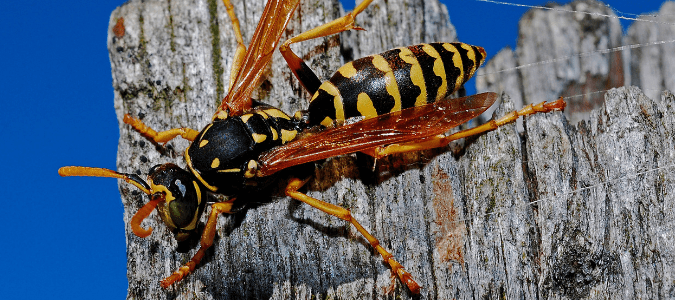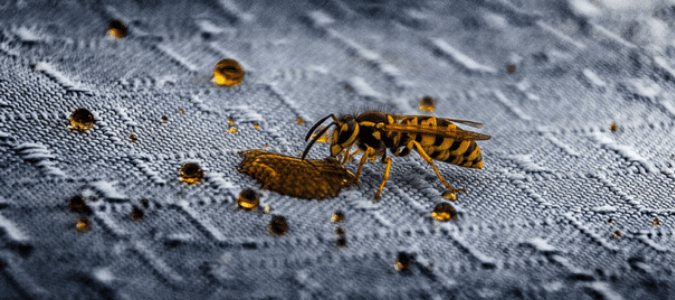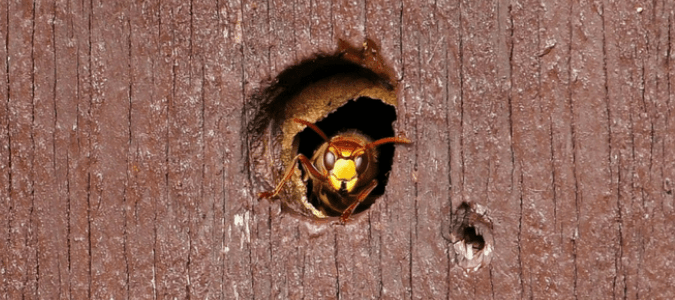
Many homeowners have had the unpleasant experience of encountering a wasp while doing yard work or sitting outside with a cool drink. When wasps are around, it’s not easy to enjoy your outdoor living spaces. Since these flying pests are known for their aggressive behavior, it’s valid to wonder: Do wasps bite or sting?
Whether you’ve spotted just one lone wasp, a couple of them or even an entire nest, it’s smart to proceed with caution. While wasps don’t bite humans, they do sting, and these stings typically cause red, painful welts. Fortunately, even if you’re allergic to wasps, a sting from one of these pests isn’t likely to cause serious complications like anaphylactic shock, the way that bee stings can. Some people do experience more severe swelling, redness and discomfort than others at the site of a wasp sting, but most won’t suffer any life-threatening symptoms.
Still, wasp stings are distinctly uncomfortable, and they are all too common—especially in summer months, when wasps are most active and people spend lots of time outdoors. Furthermore, certain types of wasps are more aggressive than others. Read on to learn more about which types of wasp are most likely to sting a human, how to identify a wasp sting, what symptoms to expect when you’ve been stung and how to keep wasps away from your home and outdoor living areas.
What Does A Wasp Sting Look Like And What Are The Symptoms?
If you’ve been spending time outdoors and suddenly find yourself with a red, itchy or painful welt on your skin, sometimes it can be hard to know whether you’ve been stung by a wasp or a bee, or if you may have suffered a sting or bite from some other insect entirely. For this reason, it’s important to know what a wasp sting looks like and what the symptoms are. If you are the victim of a sting and want to avoid a future similar encounter, you’ll probably also want to better understand what types of wasps typically sting humans and how to identify them.
Surprisingly, the number of wasp species that typically sting humans is relatively small. Paper wasps have slender bodies with black and yellow to red markings. Some homeowners may describe this species as an orange wasp, although in a majority of cases, the wasps are an orange-red color.
Yellow jackets, another common type of stinging wasp, also have black bodies with yellow bands, and thus are easily confused with paper wasps. There are distinct differences between the two, however. Yellow jackets have bodies that are thicker than paper wasps’ bodies, and they are generally far more aggressive. While paper wasps will display aggressive behavior when provoked, such as if their nests are threatened, yellow jackets will attack humans even more aggressively, and with less provocation.
Mud daubers are another common type of wasp, so named because they build their nests out of mud. Since there are many different types of mud daubers, their colors, markings and appearances vary widely; some are even black and yellow, like paper wasps and yellow jackets. Most mud daubers are not typically aggressive, however, and usually won’t even attack to protect their nests. These flying insects might sting if someone picks them up or mishandles them, but they are relatively low on the list of wasps that are threatening to humans.
Since there are several types of wasp that have black and yellow markings, it’s not uncommon for people to confuse wasps with bees. There are several key differences between wasps and bees, however, including the fact that bees have hairy bodies, while wasps are usually smooth, shiny and hairless, and the fact that wasps can sting multiple times during an attack.
So what does a wasp sting look like, and what are the symptoms? Most wasp stings cause raised red welts at the site of the sting; there may be a white spot in the very center of the welt, where the stinger entered the skin. You won’t find the stinger itself in your skin, however, as wasps, unlike bees, retain their stinger. The pain, redness and swelling at the site of the sting might increase at first, but should decrease over the course of a few hours, especially if ice is applied to the sting site.
Wasp Sting Remedy: How Can I Care For My Sting At Home?
If you’re looking for a wasp sting remedy that you can use to care for your sting at home, you’re in luck: Many people’s reactions to wasp stings are mild enough that they can easily treat their stings at home, often with items they already have in their freezer or medicine cabinet. Some stings, however, do require the attention of a doctor. Read on to find out how to treat your wasp sting according to the severity of your symptoms.
Treatment For Mild Reaction Symptoms
Treating a mild reaction to a wasp sting is relatively simple. First, wash the area with soap and water, and then apply an ice pack or a package of frozen vegetables to reduce pain and swelling. Rubbing a cut clove of garlic or placing cold cucumber slices over the affected area can be very effective at reducing pain. If these natural remedies don’t help, other topical treatments like hydrocortisone cream or calamine lotion should control any itching and discomfort. An over-the-counter antihistamine may also help reduce symptoms more quickly. Be sure to keep the area clean and dry as it heals; you can even cover the wound with a bandage, if desired, until the sting has healed completely.
Treatment For Moderate Reaction Symptoms
Moderate reactions to wasp stings are not life-threatening, but they do require more care and attention than a milder reaction. People who are allergic to wasp stings might experience symptoms of a moderate reaction, such as extreme redness and swelling that doesn’t improve after a few hours; in fact, these may not improve for several days. These people may also experience nausea and vomiting. While most people with a moderate reaction to a wasp sting can use the at-home treatments described above and should feel better within a week, it’s still a smart idea to visit your doctor for a professional diagnosis and advice about controlling symptoms.
Treatment For Severe Reaction Symptoms
Severe allergic reactions to wasp stings are rare, but possible. It is also possible that someone experiencing a severe reaction to a wasp sting has actually been stung by a bee, and is having an allergic reaction to that. If you or someone you love has a severe reaction to a wasp sting and goes into anaphylactic shock, they might experience a quick onset of symptoms such as severe swelling of the face, lips or throat; difficulty breathing; hives; dizziness, lightheadedness or a sudden drop in blood pressure; nausea, vomiting, diarrhea or stomach cramps or loss of consciousness. If a wasp sting causes any of these reactions, it is very important to get immediate medical attention as soon as possible. This is especially true if you aren’t certain whether the sting came from a wasp, bee or hornet, since bee stings can cause extreme and life-threatening reactions in people who are allergic to them.

Why Do Wasps Sting And How Can I Protect Myself From Being Stung?
Like bees and hornets, wasps use their stingers for self-defense. When they sting someone, these insects transmit venom, which is the source of all that unwelcome itchiness, swelling and discomfort. Bees’ stingers often get stuck in their victims, which means they can sting only one time their whole lives. Wasps, on the other hand, retain their stinger, which means they can deliver multiple stings—either to many victims over time, or to just one victim over and over again (ouch!).
For many of us, it’s hard to stay calm when a wasp flies or touches down nearby, but if you’re trying to avoid getting stung, it’s important to keep your cool. This means keeping still, rather than flailing your arms around or taking a more aggressive approach in an attempt to scare the stinging insect away. Wasps can sense when someone is trying to harm them, which is why threatening them with folded newspapers, flyswatters or wild hand movements isn’t likely to help. Instead, doing so could cause the wasp to go on the offensive.
Fortunately, there are a number of different ways homeowners can protect themselves from danger. Along with staying calm and still when a wasp approaches, it also helps to avoid wearing bright clothing, open shoes or strong scents (especially sweet or flowery scents). Avoid leaving sugary foods or beverages unattended, especially in settings prone to wasp activity. Most of all, if you find a wasps’ nest, stay away from it, in case there are any wasps present that might sense their home being threatened.

How To Keep Wasps Away From Your Home To Protect Your Family And Pets
Did you know that wasps can be a danger not just to people, but also to furry four-legged friends as well? When it comes to attacking the source of a threat, wasps don’t discriminate between humans and other animals. If a wasp senses danger coming from your dog or cat, it could attack and sting your pet. If your pet is stung inside the mouth or throat, be sure to monitor the animal very closely for any signs of swelling or difficulty breathing. If there is any indication that your pet is having trouble swallowing or breathing, or if it starts vomiting, having diarrhea or experiencing other serious symptoms, it’s time to call the vet.
Just as with humans, pets with milder reactions to wasp stings can find comfort in ice packs applied to the site of the sting. The animal should feel better within a few hours, and all symptoms related to the sting should subside within a few days.
To keep wasps away from you and your loved ones, it’s helpful to know more about what attracts wasps. What lures these creatures to your property is the same thing that brings other pests to your home and lawn: food, water and shelter. Food may come in the form of left-behind cans and glasses in your yard containing soda, juice or other sugary drinks. Being vigilant about bringing food waste, cans and wiping down tables after eating outside can help make your property less attractive to these stinging insects. Also, make sure your trash cans remain tightly closed, as waps tend to congregate around these containers, in search of food.
If wasps are a problem around your home, you may wish to try to eliminate them yourself by spraying their nests or knocking them down. Proceed with great caution if you do, since many types of wasp will attack vigorously when threatened. Be sure to wait until early in the morning or late in the evening, when wasps are less active than they are in the daytime. Wear long sleeves and pants to protect as much of your skin as possible, make sure all children and pets are far away, and use a far-reaching pesticide spray that works on contact, so that you can stand at a distance while you thoroughly coat the nest. You can also try a high-pressure spray of water if you want to avoid the use of chemicals. Be ready to run for shelter if the wasps go on the attack!
ABC Can Solve Your Wasp Problem
For most people with a wasp problem, it’s far simpler to hire a pest-control specialist to treat the property than risk getting stung, especially since wasps can sting multiple times. The pest control professionals at ABC Home & Commercial Services are well versed in dealing with wasps, bees and hornets, and we know what types of behavior to expect from these pests. We have specialized tools and techniques for meeting each home’s specific needs, including high-up nests on multi-story homes that would be hard to access for most homeowners. We also know where to find the less obvious spots and points of entry where wasps might build hidden nests. We will be happy to set up a regular schedule for keeping your home wasp-free year-round, so you can enjoy your outdoor living spaces with peace of mind.

